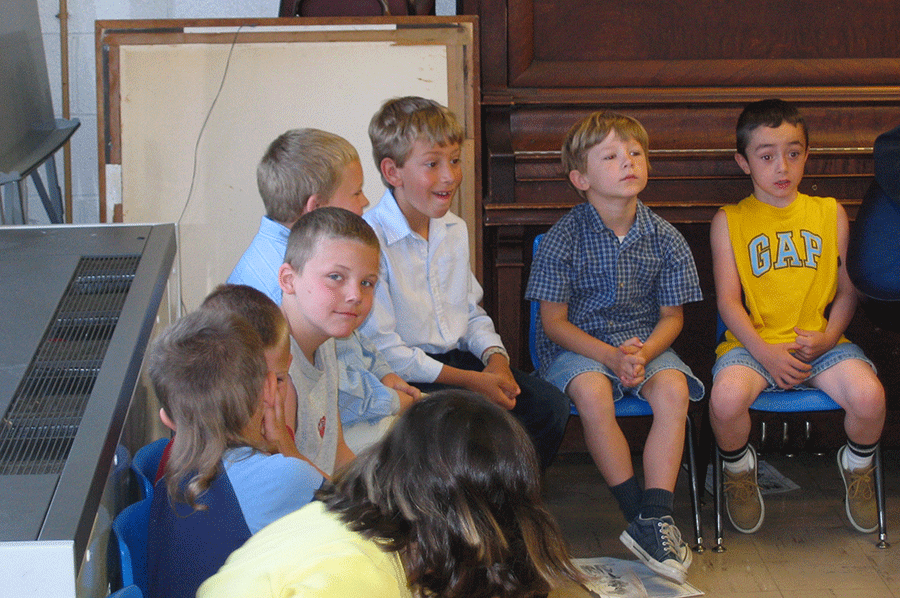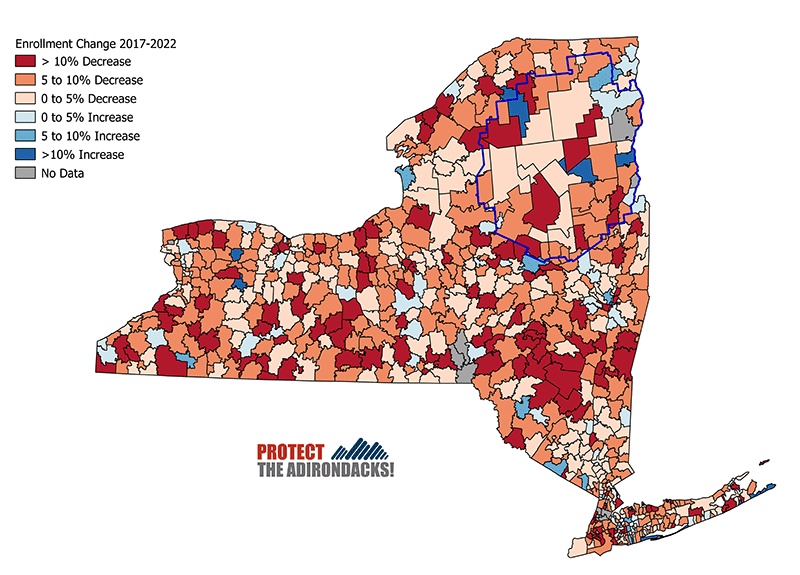The answer appears to be not so much. School district enrollment trends in New York State have been consistent for the last few decades, and an assessment of enrollment numbers over the last five years doesn’t show a big or lasting change to these trends. The last five years for which we have data, 2017-18 to 2021-22 (2022-23 data will not be released until September 2023), show that student enrollment in the 718 school districts across New York collectively dropped from 2,607,284 K-12 students in the 2017-18 school year to 2,418,569 in 2021-22, a loss of 188,715 students.
In New York State today, there are more than a million fewer school children than in 1970, though the state’s population has been flat. Just ten years ago, in the 2011-12 school year, there were 2,699,840 students, over 280,000 more than now. The drop in the last five years is consistent with long-term trends. Decade after decade, losses continue as New York’s population ages and families choose to have fewer children.
Unfortunately, we do not have fully detailed 2020 US Census data yet, which would help us drill down further on changes to the age composition in New York and the rest of the country. Regional variations will be interesting to assess. The limited data produced so far for voting redistricting purposes provided information on residents 18 years old and older and those younger. From this data, we saw that from 2010 to 2020, New York State saw a -4.9% drop in young people under 18 years old, some 211,815 fewer kids. Yet, in the last decade, New York’s population also grew by over 825,000. This means that during a decade in which New York’s total population increased by over 825,000, the population 18 years old or older grew by over 1 million, while the population of young people under 18 years old shrank by over 200,000.
New York’s total school district enrollment has been declining for decades. Often, one district’s stats will be held up as evidence of a community’s decline, but school enrollment is best understood in a larger context. The drop in the last five years of over 188,000 K-12 students is consistent with current trends. Losses were pervasive throughout the state; 692 of New York’s 718 school districts saw enrollment drops over the last five years, fully 87% (see map below). The average drop in enrollment was -7.2%.
In the Adirondack Park, over the last five years, most school districts contracted, though many were well below the state average. There were some districts that posted gains. In Clinton County, Au Sable Valley saw a 1.26% rise and the Saranac district, outside of Plattsburgh, was up 96 students with a 6.76% gain. Peru saw a modest -2.8% drop.
In Essex County over the last five years, Minerva (12.32%) and Crown Point (18.63%) were up, while Lake Placid (-14.14%) and Newcomb (-12.99%) saw the biggest losses. Growth in Minerva and Crown Point could be a fluke, or it could be that these places are more affordable to working Adirondack residents than the Lake Placid area, which faces steep housing costs. Keene saw a loss of seven students (-4%) and a K-12 enrollment of 166. Moriah saw a loss of 23 kids (-3.23% drop) and an enrollment of 689. In Franklin County, Saranac Lake saw a -4.84% drop (57 students) and Tupper Lake experienced a -3.94% drop (98 students).
In Hamilton County, all four districts saw declines in enrollment, from -1.49% in Long Lake (1 student) to -18.6% in Lake Pleasant (16 students). In Herkimer County, the Town of Webb saw a net loss of 6 students, -2.28% drop. In Fulton County, Northville was down 12 students, -2.71% and Broadalbin-Perth saw a loss of 98 students, -5.47%. In Warren County, Bolton was down -15.98% and Lake George dropped -16.45%. The steep rise in housing prices in these communities must play a role. Johnsburg dropped by nearly -10% and North Warren by nearly -8%.
Something cool must be happening on the east side of Lake George in Putnam as the elementary school there, which feeds into the Ticonderoga district, nearly doubled its enrollment, rising from 29 students to 50.
In St. Lawrence County, Colton-Pierrepont gained 49 students (14.29%), while Clifton-Fine dropped -19.87% (63 students) with an enrollment of 254. Parishville-Hopkinton dropped -20.14% (87 students) with an enrollment of 345. St. Lawrence districts outside the Adirondacks of Canton (-13.52%), Ogdensburg (-9.6%), Massena (-5.85%), and Postdam (-1.86%) all dropped as well.
Three school districts were newly created in New York through mergers in the last five years, two in the Adirondacks and one in Columbia County. In Essex County the Boquet Valley Central School was created in a merger between Elizabethtown and Westport. In the western Adirondacks, Inlet and Town of Webb merged. In Columbia County, the Berkshire district merged with the larger Kinderhook district.
US Census data from 2010 to 2020 showed us that there were over 211,000 fewer school-age children in New York State, even as our population grew. This trend is not confined to New York but intensifies and plays out the same way in all the neighboring Northeast U.S. states. From 2010 to 2020, New Jersey experienced a -2.8% drop (-57,530) in young people under 18 years old, and Massachusetts saw a -3.7% drop (-52,729). Pennsylvania saw a -5.1% drop (-143,003), Rhode Island saw a -6.3% drop (-14,171), Maine saw a -8.1% drop (-22,259), Vermont saw a -8.2% (-10,638) loss, and Connecticut saw a -9.8% loss (-80,298). New Hampshire led the country with the biggest percentage drop in its number of young people under 18 years old with a -10.6% drop (-30,385).
This collective loss of over 622,000 young people throughout the Northeast U.S. occurred in a decade in which these nine states saw a population growth of almost 2.3 million. Think about that – the nine Northeast U.S. states together gained 2.3 million new residents from 2010 to 2020 yet saw a net loss of 622,000 young people under the age of 18.
These long-term trends will be tough to break. I remember attending a meeting in Lake Placid and listening to an impassioned speech about Lake Placid’s declining elementary school numbers. A woman in her forties, and a mother of a single child, decried her child’s small grade size, saying it was less than half the size of when she had attended that school thirty years before. When she attended elementary school she did so with a sibling in tow. She’s the sum of her own fears. Yet, it seems, that the bigger questions are not found in comparisons to 30 years ago, but rather on creating the most dynamic educational opportunities we can that take full advantage of small class sizes.
If there is a Covid effect in New York to school enrollments, it may be seen in the drop in New York City school students. In the last five years, over 100,000 students dropped from the City’s enrollments and these losses were widespread among all but one of the boroughs. School districts in the Bronx saw a loss of 34,307 students. Brooklyn saw a loss of 25,560 students, Manhattan dropped 15,618, and Queens dropped 24,754. Staten Island was basically flat, dropping just 434 students.
In 2011-12, the City had 1,022,644 students compared with 2021-22 levels of 907,834. Over the last decade the City’s enrollment hovered around one million kids before Covid, and stood at 1,008,472 in 2017-18, but a variety of factors, from the pandemic to rising housing costs and the high cost of living, are possibly fueling the drop beyond larger New York State factors of an aging population and smaller family size.
In the Adirondacks and Upstate New York, perhaps school district losses were minimized by families relocating north during the pandemic. The overall school populations may have stabilized or leveled off partly from families relocating Upstate. But it does not appear from the data at this point that there was a major longstanding shift or change from dominant trends.
In the Adirondacks, school districts will likely continue to see declines, pressured by enduring New York State trends of an aging population and the fact that many people who choose to become parents choose small families with few kids. These trends are compounded in many communities by housing prices out of reach of working people, fueled by the vacation home market, short-term rentals, and speculation. We may have also reached a point where things are stable. Hamilton County, for instance, saw a change of just 25 kids over the last five years, and many other Adirondack school districts were in the single digits.
We’re amidst national demographic changes in the U.S. that are intensifying and playing out across Upstate New York and the Adirondacks. More Americans are choosing to live in urban and suburban areas. More jobs are being created and relocated to urban and suburban areas. More large employers are choosing to operate in urban and suburban areas. We’ll see if remote work holds or if the traditional office is reasserted.
Across Rural America, in areas very similar to Adirondack Park, communities are experiencing the same trends of an aging population, slow overall population loss, and a decline in school enrollments. We’re not alone, far from it. We’re not unique, we’re the rule not the exception. By our estimate, just six million Americans today have made a choice to live in the vast thinly populated rural lands that occupy over 60% of the continental U.S. When one looks west or south from Blue Mountain Lake, in the center of the Adirondack Park in northern Hamilton County, there’s a whole lot of other lightly populated areas like Hamilton County out there, spreading out across the U.S. from sea to sea, dotted here and there by cities ringed by suburbs. And their reality is the same as our’s.







